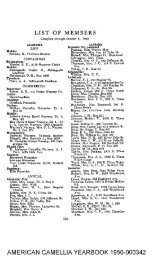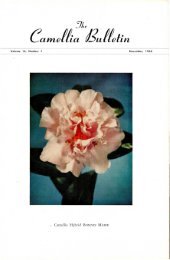CAMELLIA JAPONICA - GOVERNOR EARL WARREN - Immense ...
CAMELLIA JAPONICA - GOVERNOR EARL WARREN - Immense ...
CAMELLIA JAPONICA - GOVERNOR EARL WARREN - Immense ...
You also want an ePaper? Increase the reach of your titles
YUMPU automatically turns print PDFs into web optimized ePapers that Google loves.
shavings (I use redwood and pine<br />
shavings mixed), then cover the shavings<br />
with peet moss. The shavings<br />
and peet moss act as a sponge to<br />
hold the moisture and as' a filter to<br />
prevent fine particles of soil from<br />
washing into the drainage field. The<br />
pot is now ready for the soil mixture.<br />
Fill the container half full of prepared<br />
soil and firm with the fingers,<br />
making a cone in the center. Place<br />
the roots of the young plant over the<br />
cone so that they point outward and<br />
downward in all directions. Hold the<br />
stem of the plant in the center of the<br />
container with one hand and fill in<br />
soil mix with the other and firm until<br />
the soil is about I inch above the<br />
root crown. Mulch the top with about<br />
I inch of pine needles and water<br />
thoroughly until drainage is observed<br />
from the bottom of the container.<br />
Place the young plant in a shaded<br />
location for two or three months until<br />
it becomes thoroughly established in<br />
the soil; then place in a partially<br />
shaded location.<br />
The most favorable time for potting<br />
rooted cuttings is October and November.<br />
Potting Mix for Rooted Cuttings<br />
and Seedlings<br />
The potting mix for young camellia<br />
plants should be loose but friable,<br />
of a texture that will stimulate root<br />
growth and allow easy penetration<br />
by the tender, young roots.<br />
The following soil mixture has<br />
given me satisfactory results for the<br />
potting of rooted cuttings and seedlings:<br />
25% or I part garden loam<br />
25 % or 1 part medium fine builder's<br />
sand<br />
50% or 2 parts humus, composed<br />
of equal parts of oak-leaf mold and<br />
Canadian peet.<br />
Add one gallon of well-rotted cow<br />
manure to a wheelbarrow load, or<br />
about 1 to 15. Mix the fertilizer thoroughly<br />
into the mix.<br />
Northern California Camellia Society 19<br />
The manure, plus the organic plant<br />
foods liberated by the humus, will<br />
furnish sufficient nutrient for the first<br />
six months. The humus will also keep<br />
the growing medium sufficiently acid<br />
to stimulate healthy plant growth.<br />
The soil in the mix will furnish other<br />
minerals necessary until the spring<br />
months, at which time, mild feedings<br />
of liquid fertilizer may be applied as<br />
directed below under fertilizing.<br />
Watering Rooted Cuttings and<br />
Seedlings<br />
Water the young plants about once<br />
a week, depending upon weather<br />
conditions and the amount of shade<br />
provided. The plants should be kept<br />
moist but not soggy.<br />
Fertilizing Rooted Cutlings and<br />
Seedlings<br />
Assuming that the rooted cuttings<br />
were potted in October and November,<br />
a weak solution of liquid fertilizer'<br />
may be applied, beginning in<br />
March of the following spring. Apply<br />
the liquid fertilizer about March 1,<br />
May 1, and July 1. The solution for<br />
small plants should be not more than<br />
one-fourth the strength recommended<br />
by the manufacturer. Discontinue fertilizing<br />
after July I to allow new<br />
growth before winter.<br />
Repotting to Larger Containers<br />
Rooted cuttings originally placed<br />
in 4-inch pots or one-quart metal containers<br />
should be repotted into gallon<br />
containers or 6-inch pots at the end<br />
of the first year. They may remain in<br />
these larger containers for two years<br />
unless excessive growth indicates a<br />
larger container is necessary prior to<br />
that time.<br />
Those rooted cuttings initially<br />
placed in 6-inch pots or gallon containers<br />
may remain in the original<br />
containers for two years, when they<br />
should be removed to 2 to 3-gallon<br />
containers, using a soil mix such as<br />
presented below.




